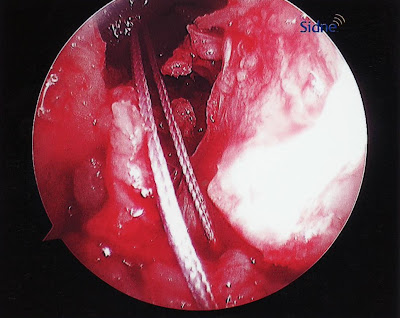



The surgeon gave me a set of pictures taken during my ACL reconstruction and Meniscus repair.
While these procedures are well known, proven and 'nothing new', it's always more interesting when it's ones own knee that's being looked at.
The first picture shows my old torn ACL which has literally been hanging around and doing nothing for a decade, it was removed.
The second picture shows the guide wire that was used to thread the donor ACL graft into place. Holes were drilled in my upper and lower leg bones to allow the replacement ACL to be drawn into place by pulling on the attached guide wire. The replacement ACL was then screwed into place with the amount of tension that is required for it to perform it's binding function.
The third picture shows the new ACL graft in place. It's the fuzzy white blob in the middle. As the graft doesn't arrive until shortly before surgery, I requested of the surgeon that he abort the surgery in the 1/1000000 chance that the donor graft looks deficient in any way. After the operation he told me that the graft looked good and was 9mm in width (mmm.. slightly more than 1/3 of an inch).
The fourth picture shows the meniscus repair. The edges of the torn meniscus were roughed up to make them bleed which stimulates the growth of repair tissue. The surgeon stapled the ends together to hold them in place and the body will do the rest. There's a 90% chance that the repair will take and that I will emerge from my 5 more weeks of crutch-encrusted life with a whole, complete meniscus.
I'm really looking forward to a future with a strong and healthy knee !



